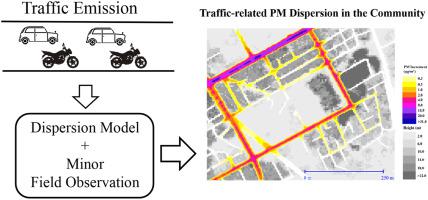Environmental Pollution ( IF 7.6 ) Pub Date : 2020-06-29 , DOI: 10.1016/j.envpol.2020.115046 Hong Ling , Shih-Chun Candice Lung , Ulrich Uhrner

|
Conducting studies on sharp particulate matter (PM) gradients in Asian residential communities is difficult due to their complex building arrangements and various emission sources, particularly road traffic. In this study, a synthetic methodology, combining numerical simulations and minor field observations, was set up to investigate the dispersion of traffic-related PM in a typical Asian residential community and its contribution to PM exposure. A Lagrangian particle model (GRAL) was applied to estimate the spatiotemporal variation of the traffic-related PM increments within the community. A detailed topography dataset with 5 m horizontal resolution was used to simulate a micro-scale flow field. The model performance was comprehensively validated using both in-situ and mobile observations. The coefficient of determination (R2) of the simulated vs. observed PM2.5 reached 0.81 by an artery road, and 0.85 in alleys without significant road traffic. The maximum increments of kerbside PM exposure concentration contributed by road traffic during rush hour were found to be 38% (PM10) and 40% (PM2.5). This synthetic method was used to assess the impact of synoptic wind and canyon orientation on residents' PM2.5 exposure related to traffic exhaust. Perfect exponential decay curves of traffic-related PM2.5 were found within canyons. The decrease of road-traffic PM2.5 on five different floor levels, compared with that on kerbside levels, ranged between 42% and 100%. The results demonstrated that in complex Asian communities, Lagrangian particle models such as GRAL can simulate the spatial distribution of PM10 and PM2.5 and assess the residents’ outdoor exposure.
中文翻译:

亚洲居民社区中的微观尺度粒子模拟和与交通有关的粒子暴露评估。
由于亚洲居民社区复杂的建筑布置和各种排放源,尤其是道路交通,因此很难对亚洲居民社区中的急剧颗粒物(PM)梯度进行研究。在这项研究中,建立了一种综合的方法,结合了数值模拟和较小的现场观察,以研究与交通有关的PM在典型的亚洲居民社区中的分布及其对PM暴露的影响。应用拉格朗日粒子模型(GRAL)估算社区内与交通相关的PM增量的时空变化。使用水平分辨率为5 m的详细地形数据集来模拟微尺度流场。使用现场观察和移动观察对模型性能进行了全面验证。测定系数(R2)的模拟和观察到的PM 2.5通过一条动脉道路达到0.81,在没有明显道路交通的小巷中达到0.85。在高峰时间,道路交通对路边PM暴露浓度的最大增量为38%(PM 10)和40%(PM 2.5)。该合成方法用于评估天气的风向和峡谷朝向对居民与交通尾气相关的PM 2.5暴露的影响。在峡谷内发现了与交通相关的PM 2.5的完美指数衰减曲线。道路交通PM 2.5的减少与路边水平相比,五个不同楼层的水平介于42%和100%之间。结果表明,在亚洲复杂社区中,拉格朗日粒子模型(如GRAL)可以模拟PM 10和PM 2.5的空间分布,并评估居民的室外暴露情况。









































 京公网安备 11010802027423号
京公网安备 11010802027423号